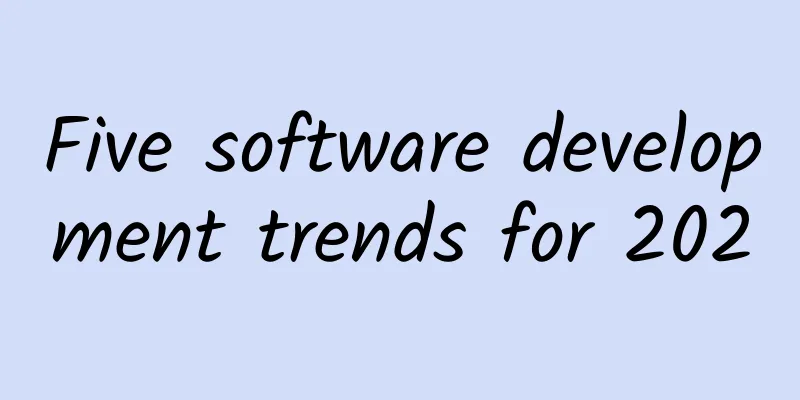Five software development trends for 2020

|
Over the past few years, a lot of software development technology has changed dramatically. DevOps became the norm, the world became application-centric, and framework technology was in full swing. David Cramer, CEO and co-founder of Sentry, predicts the trends that will emerge in 2020 and looks ahead to the next decade.
A central theme has emerged over the past decade: the world has become app-centric. From payments to ride-sharing, from online shopping to social media, as users demand more and better digital experiences, organizations across industries are refocusing their resources on building the best apps. This has unleashed trends for 2020 and beyond, particularly around front-end development and the tools and frameworks that support it. Here are a few things people can expect as we head into the new decade: As capabilities shift, the front end will meet DevOps How people interact with websites is no longer just a marketing issue. The user interface is now critical application code, and it contains the core business logic. This shift in the importance of applications means that front-end development teams will start to look more like product teams as development and operations merge. These teams are deploying their own code and making changes so quickly that they often move too fast for the various operations teams to get the full context to mitigate application errors. As the process becomes a continuous cycle of integration and delivery, we will see these front-end teams become more versatile in their skills and responsible for development, testing, and operations. These teams will be on call and interact more with monitoring tools to ensure normal operation. Developers who write JavaScript will learn how to paginate. Tool and framework frenzy will continue; fatigue will intensify The plethora of tools, languages, and frameworks adds tremendous complexity to the application development ecosystem. IT teams are challenged to interconnect these disparate languages and platforms to build the applications that are the lifeblood of businesses in today’s digital economy. Despite cries of tool and framework fatigue, there still isn’t a clear-cut solution in 2020. In fact, there may be more disruption. While it looks like React.js is on its way to victory in front-end development, there are still a number of viable competitors ready to shake things up. On the back-end, despite significant innovation in recent years, there’s still no standardization. PHP, Ruby, Python, Node.js, Java, and .Net are all in use, but there’s no clear winner yet, and that won’t change in 2020. Even more tools — many of which will be open source — will integrate the technologies as teams work to connect it all, but the challenges of complexity and control will get tougher before they get better. JavaScript will win the language debate and become the glue of modern applications Today, there is no real choice of programming language for building modern web applications, but as the battle for the front-end heats up, JavaScript is becoming more and more popular. In the next few years, we will see a clear shift towards JavaScript, which will universally become the language of choice for user interfaces on every platform. More tools will emerge and adapt to front-end specific applications, and JavaScript will be the glue that connects them all. Turn to merger In recent years, innovation has revealed a plethora of new tools from large vendors, startups, and open source projects, each promising to solve the next big problem. However, maintaining compliance and control when mixing technologies of varying maturity levels is a challenge. While the next decade will certainly bring more innovation, we can also expect the trend to begin to shift toward a consolidation of platforms and tools as overwhelmed IT teams seek ways to simplify their stacks and reduce risk. Vendors that offer common solutions that span multiple platforms and integrate seamlessly into enterprise environments will continue to be adopted. While enterprises may continue to offload infrastructure management to third parties (cloud vendors and SaaS providers, etc.) to reallocate their resources to building their business, interest in new tools that only provide 1% added value will fall by the wayside. Engineering issues will align with user issues, changing the way applications are monitored As people invest more and more in user interfaces (which will increasingly become actual applications), you'll see the engineering focus move closer to the customer focus, which means a lot of the tools and responsibilities will change as well. People will need to monitor more than just the availability of backend servers; they will need to monitor how customers interact with products and businesses, as each application iteration can have a positive or negative impact on the user experience. When development teams have a more complete understanding of user interactions and application performance, they can more effectively build applications that drive business value. |
<<: QQ is updated again! A wave of new features is coming
Recommend
Can a spacecraft be blown away with just one breath?
If I say that I can blow away Tiangong-1 with one...
Getting started with Android Studio jni development——Just look at me!
This article records the basic configuration and ...
What’s the point of doing business if you can’t find any competitors?
How many times have you heard this? Anyway, I hav...
The United States has quadrupled its tariffs on Chinese electric vehicles, and the boomerang may eventually hit Tesla
On May 14, the shoe dropped and the United States...
Military Advisor's Office Four Pillars Learning Elementary and Intermediate Class
Resource introduction of the Military Advisor'...
How to make 100,000 RMB a month with Douyin local food accounts
I think many people thought when they were young ...
OPPO Find7 User Experience
I have used the Fan 7 for 3 days. I want to write ...
6 analysis methods to teach you how to quickly diagnose SEM account performance
Only data can tell whether your promotion account...
Besides drinking porridge, what else does Laba Festival have to offer?
Mixed Knowledge Specially designed to cure confus...
B-side operations: How to acquire customers through activities?
For B-side products, holding events to acquire cu...
How to build a traffic circulation system
Before I start sharing how to build a traffic cir...
Event promotion: more than 60 event operation tools, this article is enough for you to organize events!
To organize a good event, it often goes through t...
A woman was hospitalized after eating raw pickles. Be careful when making your own raw pickles! It can cause diarrhea at the mildest and poisoning at the worst.
Recently, there was a trending search #Woman lear...
Postpartum recovery: abdominal shaping after cesarean section
Postpartum repair and cesarean section abdominal ...
After Hisense, Xiaomi also entered the laser TV market. Is this a sign of the future of large screens or just a delaying tactic?
While the TV industry is arguing over whether OLE...


![[Recommended blog post] Real-time rendering of seawater on Unity3D mobile terminal](/upload/images/67ebf0304baa9.webp)






